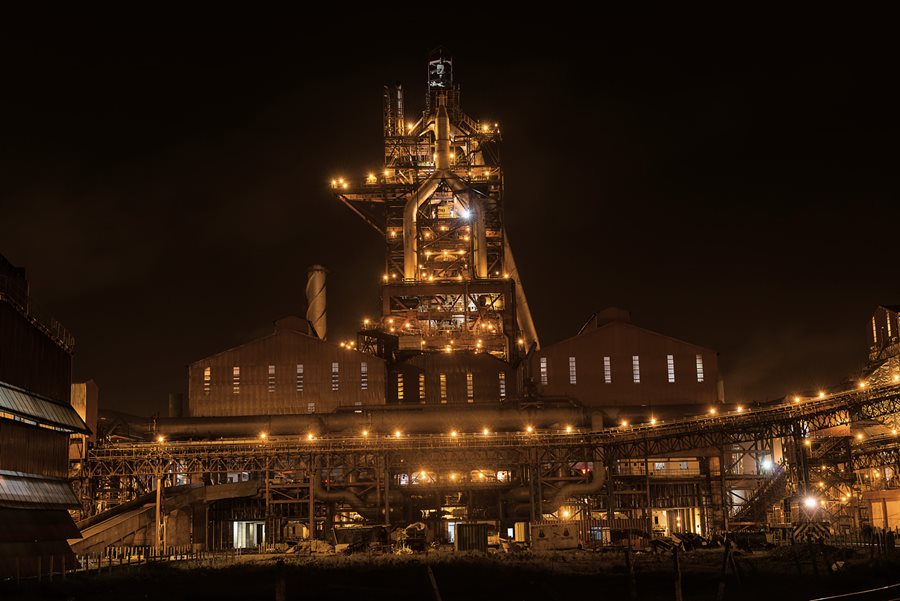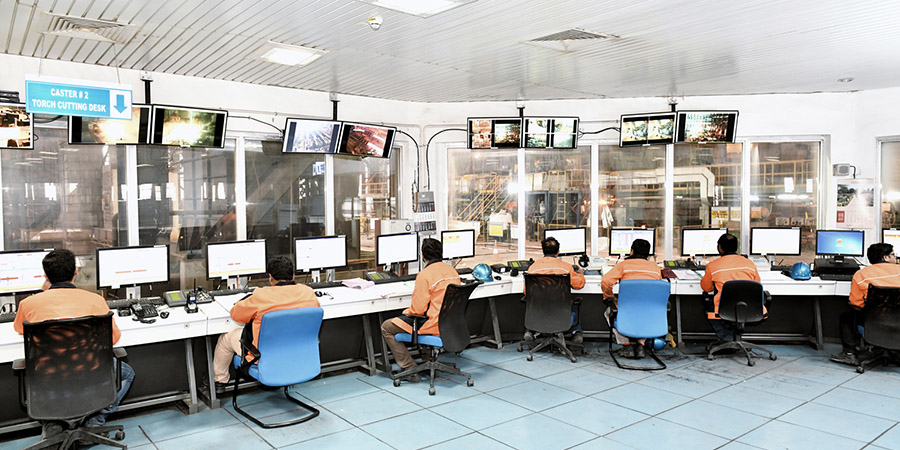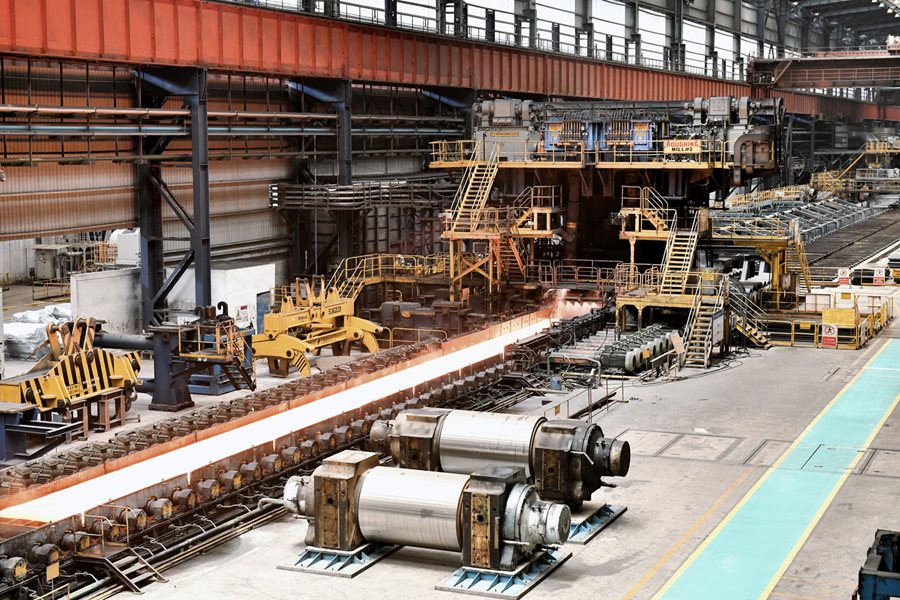By upskilling employees and innovating with analytics, Tata Steel’s plant in Kalinganagar, India, achieved performance gains that earned it recognition as a leading digital facility by the World Economic Forum.
Shortly before molten steel is cast into solid shapes at Tata Steel’s plant in Kalinganagar, India, frontline operators put the metal through a process known as superheating, which is necessary to bring the steel to the proper temperature for casting. Superheating can be tricky to get right. Steel reaches more than 1600 degrees Celsius during superheating, and the ideal temperature range spans only 15 degrees. If the steel comes out too hot, the equipment operators must slow the casting step. If the steel isn’t hot enough, it can “freeze” before it has been cast, which compromises its quality.
The frontline operators at the secondary-metallurgy station were used to running the superheating process based on past experiences. They would consider prompts from control systems, which were loaded with standard formulas, and then decide what set points to apply so the steel temperature would end up in the target range. Most of the time, they heated two of every three batches of steel into the optimal range. That “strike rate” allowed them to complete 25 “heats” per day, but it also left room for improvement. Bringing the strike rate up to 85 percent or so would result in 28 to 30 heats per day, enough to boost throughput by roughly 8 to 12 percent, or 600 to 900 daily tons.
The opportunity stood out to the plant managers, who had been given a mandate to improve the plant’s performance with advanced analytics. In early 2017, they devised a plan for building analytics models that would help frontline operators get better results from the superheating process and several other activities. Data scientists from Tata Steel and McKinsey used historical information from the plant to build and “train” a superheating-optimization model, which would examine real-time operational data and recommend process set points conducive to a higher strike rate. In addition, managers arranged for some employees to receive classroom training in data science, data engineering, and other advanced-analytics disciplines.
At first, the superheating model proposed settings that consistently improved the strike rate. But as the mix of steel orders from customers began to differ from the mix of orders recorded in the model’s training data, the model started to generate faulty recommendations—which frontline operators ceased to follow. Employees who had gone through the classroom training tried to fix the model but found the problems too complex to correct using the basic skills they’d learned. Similar difficulties arose with the models being used elsewhere in the plant.
Despite the setback, managers had seen how the advanced-analytics models reduced costs and raised output. Managers also realized that classroom training alone would not prepare employees to sustain those performance improvements. They concluded that the company would need to further cultivate employees’ analytics skills and transform their way of working. Their insight paid off. By building these capabilities, the plant would raise its performance to world-class levels and earn acclaim from the World Economic Forum in July 2019 as one of 44 Lighthouse sites that are leading in the adoption of Fourth Industrial Revolution technologies.
What worked and what didn’t: Lessons from Kalinganagar’s analytics program
Focus on business improvements, not technology improvements. Kalinganagar expanded its use of analytics quickly by targeting performance gains and building tech solutions to achieve them, rather than looking at available technologies and thinking of how to apply them.
Develop analytics talent, instead of outsourcing it. When Kalinganagar’s first-wave analytics models needed updating, the plant didn’t have in-house specialists to fix them. Hands-on training enabled the plant to cultivate the analytics talent that it needed to scale up.
Scale analytics to make it a part of everyone’s way of working. Moving beyond pilot projects produced enough value to convince holdouts to embrace working with analytics. Adoption also increased as frontline employees worked with specialists to create the tools and as managers recognized employees’ success using them.
Preparing for analytics, well ahead of its time
Tata Steel’s multiyear effort to develop analytics capabilities at the Kalinganagar plant can be traced to a decision that executives made in 2005, when the plant was first being designed and built. Analytics technologies were then years away from becoming readily applicable to businesses. Nevertheless, Tata Steel’s executives considered whether they should outfit the plant with instruments and sensors to monitor equipment and processes.
Their decision was less clear-cut than it would have been today—remote-sensing equipment is now affordable and advanced analytics has been broadly adopted. But some executives and managers foresaw that spending money on data-collection gear would prove worthwhile, even though it wasn’t yet clear how the data would be used. Amit Kumar Chatterjee, the plant’s then-head of electrical maintenance, was among those pushing to make the early investment—and even he acknowledged that at the time, the potential applications for advanced analytics were undefined.
“We didn’t have in mind how we’d use the data, except maybe for autonomous process controls. We were living in the world of physical science, where experience and equations matter most. Data science was not even on the horizon,” said Chatterjee. Even the makers of the plant’s machinery resisted adding instrumentation. “Still, we believed we should put on the sensors at that stage because we felt it would be a lot harder later on, when the uses for the data were known.”

By the mid-2010s, the leaders of the Kalinganagar plant began looking closely at what they could do with the data the plant’s sensors were collecting. In 2015, T. V. Narendran, the managing director of Tata Steel, set out a $1 billion cost-optimization goal and called on the heads of the company’s plants to map a path toward that goal. One way of boosting performance, he suggested, was to do more with digital technology. Advances in hardware and data science had made it easier for companies to take big data sets, uncover patterns, and make predictions that could help them attain performance improvements.
Leaders at Kalinganagar launched their own investigation into how the plant might apply data science. In 2016, they traveled to Germany and visited technology start-ups and large established companies to get a close look at what data science could do. Early the following year, the plant’s leaders resolved to start an advanced-analytics program at Kalinganagar.
Beginning the analytics transformation
Senior managers at Kalinganagar decided to try advanced analytics on several pilot projects. During a two-day workshop, managers and operations specialists worked with McKinsey experts to identify ten possible uses for analytics and selected three to focus on—one of which involved the superheating process in the plant’s secondary-metallurgy station. Managers wanted to create an advanced-analytics model that could assess conditions in the plant and calculate how much heat to apply during superheating so that the steel would emerge in the target temperature range.
The team working on the superheating model sought to discern which variables were the most important determinants of the steel’s final temperature, and thereby learn how operators could improve the strike rate. They pulled together two years’ worth of operational data that had been generated by sensors or recorded manually in logbooks. Data scientists wrote algorithms to make connections among key factors: measures of the condition of the steel as it reached the secondary-metallurgy station, equipment settings that operators would adjust during the superheating cycle, and other settings that couldn’t be adjusted during a cycle but could be altered over time (such as the maximum rate of oxygen flow, capped by the equipment already in place).
After two weeks, the team had built a model capable of predicting, with 75 percent accuracy, whether a group of set-point recommendations would cause the molten steel to reach the casting station in the desired temperature range. The other two pilot-project teams built models of similar reliability. Although none of the models had yet been put to the test on the plant floor, the preliminary results convinced leaders at Kalinganagar to expand the analytics effort and create models that employees would actually use.
In September 2017, leaders laid out five operational areas in which they wanted to improve the plant’s critical performance indicators—energy consumption, throughput, quality, and yield—and believed that analytics could help. They chose to carry over the work on the superheating model to the first full phase of the project. Together, the five areas had the potential to enhance margins by $10 million annually.

Ramping up
As operations teams and analytics specialists built the phase-one models, leaders at Kalinganagar sponsored an effort to begin training some 130 employees—which comprised one-quarter of the managerial staff—in analytics. With McKinsey, the plant set up an introductory analytics academy, installed a 15-member faculty, and created 50-hour curricula for five roles: digital champion, project owner, business translator, data scientist, and data engineer. Students performed simple practice exercises in line with the duties dictated by their roles.
Although the models from the first phase worked well for a time, they started to falter as conditions in the plant deviated from the conditions that the models had been optimized for. The employees who had been through the academy tried to fix the models but could not do so using the basic techniques they’d learned by that point. And they had yet to work as apprentices on analytics projects, which would have given them hands-on experience retraining models. They simply needed more real-world exposure to analytics.
Challenges also arose as frontline operators tried to start working with the models. Shailendra Rai, the chief of blast-furnace operations at Kalinganagar, recalled that operators never became comfortable with a model that had been created to help improve the stability of the blast furnace: “Most people spend 20 or 30 years learning how to operate a blast furnace. They thought that the model would be this magical solution. When the initial output from the model didn’t match their beliefs, they couldn’t understand why. They weren’t convinced it would work. The buy-in wasn’t there.”




